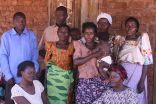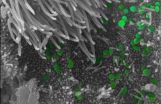(Press-News.org) URBANA, Ill. - If an in-the-flesh Extension specialist isn't available to provide training, is a video of the specialist's presentation or a video of a new agricultural practice a good substitute? The answer, according to a University of Illinois study with farmers in rural Uganda, isn't simple, particularly when gender is factored into the equation.
"The literature in the field says communication materials like videos work best to support face-to-face communication," said U of I agricultural communications professor Lulu Rodriguez. "But if you don't have an Extension specialist available in a certain locale, a video is the next best thing. The two modes of presenting information work well, particularly for African women learners. It follows the African penchant for having a live presenter, someone to talk to, and their affinity for visuals. Those are important components to how they learn. If situations get dire, a video is a viable option, particularly if there is a live facilitator."
This study explored the effectiveness of three training methods: traditional lecture-field demonstration; lecture and field demonstration plus video; and video only. A video about row bean planting was shown to groups of farmers in Kamuli District, Uganda.
Because the study was trying to uncover gender knowledge gap issues, the groups that viewed the videos were all mixed men and women. The study found that the method that combined video and lecture-demonstration was significantly more effective in narrowing the gender knowledge gap. Watching video alone improved women's knowledge scores but did not close the gap between them and their male counterparts.
"We noticed that whenever we put men and women together in a training session, the women are less likely to speak up. Men often co-opt the discussions," Rodriguez said. "The women will sit back and listen and absorb what they can. This suggests that if a video could be shown to women in a setting that doesn't require interaction with men, they would likely benefit more."
Interestingly, in terms of actual farming, Rodriguez said that women more often have the extra cash needed to implement a new innovation, and they make the decisions about what percentage of the household income will be applied to it. "Unfortunately, women's contributions are not very well acknowledged," she said.
Rodriguez explained that in Uganda, 70 to 80 percent of the agricultural labor force is women, but they don't typically have the access to resources and training opportunities that men have.
"If you want people to be aware of something, research says to use the mass media," Rodriguez said. "But if you really want people to move toward adopting an innovation, such as row planting, it's really the interpersonal communication that will make a difference. The personal touch pushed them toward adopting the practice."
Rodriguez said their study selected the video on how to plant beans in rows because it is needed to beef up the protein content of the Ugandan diet. And because the videos on row planting were already produced, it provided another opportunity to use them and in more remote locations.
"There is a dearth of extension people all over the world, so if we can get these videos distributed to villages and associations, such as farming cooperatives and informal gathering places, viewers can learn a lot by themselves," Rodriguez said. The videos used in the study featured actual Ugandan farmers who demonstrated the row method of planting beans. "People loved seeing themselves and their neighbors being interviewed."
Rodriguez would like to do more in this area--testing the use of communication technologies that might make training easier. She noted that Scientific Animations Without Borders (SAWBO) on the UIUC campus is producing high-quality training videos. Rodriguez said she'd like to test how the African audience will respond to animations as opposed to human presenters on videos.
"African society is very personal with a strong oral tradition so a real person telling a story is a style that resonates with them," Rodriguez said. "A cartoon is more impersonal but may be novel enough to get considerable attention."
"The Ability of Training Approaches to Reduce Agricultural Knowledge Gaps between Men and Women in Rural Uganda" was published in an issue of the Journal of International Agricultural and Extension Education. It was written by Tian Cai, Michigan State University; Lulu Rodriguez, University of Illinois; and Eric Abbott, Iowa State University.
INFORMATION:
CHICAGO - An important new study of men who have undergone testosterone replacement therapy has found that taking supplemental testosterone does not increase their risk of experiencing a major adverse cardiac event, such as a heart attack or stroke.
Researchers at the Intermountain Medical Center Heart Institute in Murray, Utah, which is the flagship facility for the Intermountain Healthcare system, studied 5,695 men between the ages of 53 and 71. The men, all patients at Intermountain Healthcare hospitals, had initial low testosterone levels.
Researchers found that ...
WASHINGTON, DC - November 18, 2014 - Certain subtypes of avian influenza viruses have the potential to cause more severe disease in humans than other avian influenza subtypes and should be monitored carefully to prevent spread of disease, according to a study published this week in mBio®, the online open-access journal of the American Society for Microbiology.
The work, directed by researchers at the National Institute of Allergy and Infectious Diseases in Bethesda, Md., found that flu viruses expressing the low pathogenicity avian H1, H6, H7, H10 or H15 hemagglutinins ...
(WASHINGTON, November 18, 2014) - New evidence suggests that therapeutic plasma exchange and appropriate blood testing could help patients who are in urgent need of heart surgery, but have a history of an adverse reaction to the blood thinner heparin, according to a study, published online today in Blood, the Journal of the American Society of Hematology (ASH).
Many patients who take blood thinners will eventually require some form of heart surgery, which requires the administration of large quantities of heparin to prevent clots. Some patients who have taken heparin ...
Mycoplasma gallisepticum causes chronic respiratory disease in birds. The illness particularly affects domestic chicken and turkey flocks. The bacteria are especially life-threatening for the animals when they occur in combination with other infections. In order to control the spread of the disease, poultry farms in the EU must be proven free from Mycoplasma gallisepticum or face being closed.
Mycoplasma gallisepticum is related to the human pathogen Mycoplasma pneumoniae, the causative agent of human bronchitis and pneumonia. Mycoplasmas are among the world's smallest ...
New research by a team of European physicists could explain why the universe did not collapse immediately after the Big Bang.
Studies of the Higgs particle - discovered at CERN in 2012 and responsible for giving mass to all particles - have suggested that the production of Higgs particles during the accelerating expansion of the very early universe (inflation) should have led to instability and collapse.
Scientists have been trying to find out why this didn't happen, leading to theories that there must be some new physics that will help explain the origins of the universe ...
WINSTON-SALEM, N.C. - Nov. 18, 2014 - Although every person's DNA remains the same throughout their lives, scientists know that it functions differently at different ages.
As people age, drastic changes occur in their DNA methylation patterns, which are thought to act as a "second code" on top of the DNA that can lock genes in the on or off position. However, what the consequences of these changes are remains a mystery.
To begin deciphering this process, scientists at Wake Forest Baptist Medical Center studied methylation patterns in the blood cells of 1,264 persons ...
This news release is available in German.
Are the fundamental constants really constant? Recent investigations carried out at the Physikalisch-Technische Bundesanstalt (PTB) have shown that one essential fundamental constant - namely the mass ratio of protons to electrons - can have changed only by a maximum of one part in a million over the age of our solar system (i.e. extrapolated over approx. 5 billion years). Previously, scientists deemed the possible changes to be twice as high. To obtain this result, physicists from PTB compared caesium and ytterbium atomic ...
Spices and herbs are rich in antioxidants, which may help improve triglyceride concentrations and other blood lipids, according to Penn State nutritionists.
Triglyceride levels rise after eating a high-fat meal -- which can lead to an increased risk of heart disease. If a high-antioxidant spice blend is incorporated into the meal, triglyceride levels may be reduced by as much as 30 percent when compared to eating an identical meal without the spice blend. The spiced meal included garlic powder, rosemary, oregano, cinnamon, cloves, paprika, turmeric, ginger and black pepper.
Sheila ...
Scientists have discovered how a gene mutation can lead to diseases that occur when the immune system attacks the body by mistake.
Understanding how these mechanisms work could help scientists to develop new treatments for autoimmune diseases such as Lupus and neurodegenerative conditions including Motor Neurone Disease.
Researchers found that a mutation in the gene - called ADAR1 - causes a defect in an alarm system in our cells that normally protects the body from viruses and other infections. This means that the alarm system is tripped by the cell's own molecules, ...
A new method for examining the Ebola virus genome could make surveillance quicker and cheaper for West African nations, and help detect new forms of the virus. The detailed procedure is being shared with the research community along with the study paper, which is freely available in the open access journal Genome Biology.
With over 13,000 cases and nearly 5,000 deaths in eight affected countries, the current Ebola outbreak in West Africa is the largest to date, the first to spread to densely populated urban areas, and represents the first time the virus has been diagnosed ...


